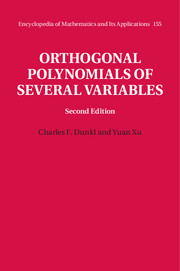Book contents
- Frontmatter
- Contents
- Preface to the Second Edition
- Preface to the First Edition
- 1 Background
- 2 Orthogonal Polynomials in Two Variables
- 3 General Properties of Orthogonal Polynomials in Several Variables
- 4 Orthogonal Polynomials on the Unit Sphere
- 5 Examples of Orthogonal Polynomials in Several Variables
- 6 Root Systems and Coxeter Groups
- 7 Spherical Harmonics Associated with Reflection Groups
- 8 Generalized Classical Orthogonal Polynomials
- 9 Summability of Orthogonal Expansions
- 10 Orthogonal Polynomials Associated with Symmetric Groups
- 11 Orthogonal Polynomials Associated with Octahedral Groups, and Applications
- References
- Author Index
- Symbol Index
- Subject Index
3 - General Properties of Orthogonal Polynomials in Several Variables
Published online by Cambridge University Press: 05 August 2014
- Frontmatter
- Contents
- Preface to the Second Edition
- Preface to the First Edition
- 1 Background
- 2 Orthogonal Polynomials in Two Variables
- 3 General Properties of Orthogonal Polynomials in Several Variables
- 4 Orthogonal Polynomials on the Unit Sphere
- 5 Examples of Orthogonal Polynomials in Several Variables
- 6 Root Systems and Coxeter Groups
- 7 Spherical Harmonics Associated with Reflection Groups
- 8 Generalized Classical Orthogonal Polynomials
- 9 Summability of Orthogonal Expansions
- 10 Orthogonal Polynomials Associated with Symmetric Groups
- 11 Orthogonal Polynomials Associated with Octahedral Groups, and Applications
- References
- Author Index
- Symbol Index
- Subject Index
Summary
In this chapter we present the general properties of orthogonal polynomials in several variables, that is, those properties that hold for orthogonal polynomials associated with weight functions that satisfy some mild conditions but are not any more specific than that.
This direction of study started with the classical work of Jackson [1936] on orthogonal polynomials in two variables. It was realized even then that the proper definition of orthogonality is in terms of polynomials of lower degree and that orthogonal bases are not unique. Most subsequent early work was focused on understanding the structure and theory in two variables. In Erdélyi et al. [1953], which documents the work up to 1950, one finds little reference to the general properties of orthogonal polynomials in more than two variables, other than (Vol. II, p. 265): “There does not seem to be an extensive general theory of orthogonal polynomials in several variables.” It was remarked there that the difficulty lies in the fact that there is no unique orthogonal system, owing to the many possible orderings of multiple sequences. And it was also pointed out that since a particular ordering usually destroys the symmetry, it is often preferable to construct biorthogonal systems. Krall and Sheffer [1967] studied and classified two-dimensional analogues of classical orthogonal polynomials as solutions of partial differential equations of the second order.
Information
- Type
- Chapter
- Information
- Orthogonal Polynomials of Several Variables , pp. 57 - 113Publisher: Cambridge University PressPrint publication year: 2014
